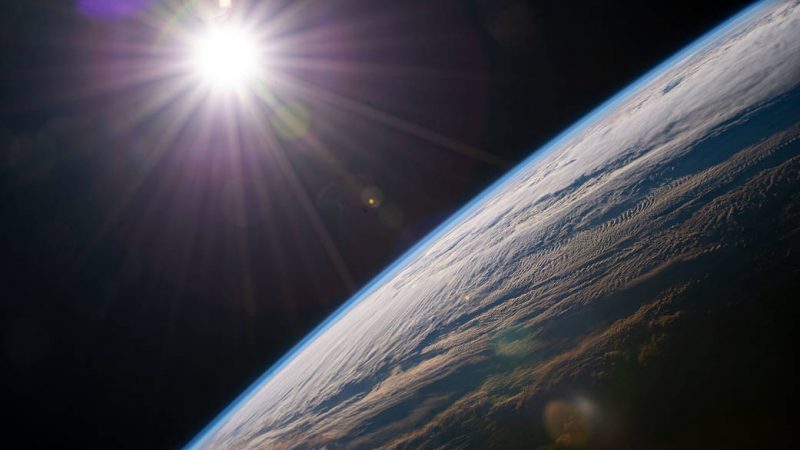
An Earth day is 24 hours long. Why?
We know that on Earth, a day is 24 hours long. But why? On July 5, 2023, a team of astrophysicists from the University of Toronto explained how the effects of the sun and moon result in a 24-hour day. They also explained why, for more than a billion years, Earth’s day length was closer to 20 hours. (It was 19.5 hours, to be precise.) And, in the future, a warming atmosphere might help lengthen a day on Earth even faster than is naturally occurring. It all has to do with the moon’s tidal pull on oceans and the sun’s tidal pull on our atmosphere.
The researchers published their peer-reviewed study in the journal Science Advances on July 5, 2023.
Earth’s days have been slowing since the beginning
When Earth first formed some 4.5 billion years ago, it spun much faster than it does today. Back then, an Earth day was approximately 10 hours long. But the moon – Earth’s relatively big, bulky companion – exerts a gravitational pull on Earth’s oceans. The moon’s pull creates two tidal bulges on Earth. And these bulges plus the friction of water against the ocean floor works like a brake on Earth’s spin.
Therefore, the speed of Earth’s spin has been slowing, and thus the day has been lengthening. Even today, the length of a day increases by 1.7 milliseconds every 100 years. Small, but measurable!
If you were to do the math of Earth’s early spin compared to today’s, you’d find that the length of our day should actually be about 60 hours by now. But obviously it’s not. Enter the sun….

The sun’s tidal force on our atmosphere
About two billion years ago until 600 million years ago, another factor came into play in Earth’s rotation: the sun. The sun creates its own tidal bulges in Earth’s atmosphere. But these have a different effect from the moon’s tidal bulges in the ocean. Norman Murray, an author of the paper from the University of Toronto, explained:
Sunlight also produces an atmospheric tide with the same type of bulges. The sun’s gravity pulls on these atmospheric bulges, producing a torque on the Earth. But instead of slowing down Earth’s rotation like the moon, it speeds it up.
The press release described how Earth’s atmosphere has a resonance, like a bell:
… some two billion years ago, the atmospheric bulges were larger because the atmosphere was warmer and because its natural resonance – the frequency at which waves move through it – matched the length of day.
The atmosphere, like a bell, resonates at a frequency determined by various factors, including temperature. In other words, waves – like those generated by the enormous eruption of the volcano Krakatoa in Indonesia in 1883 – travel through it at a velocity determined by its temperature. The same principle explains why a bell always produces the same note if its temperature is constant.
Syncing the 2 tides
In the early epochs of Earth, the atmospheric tide and Earth’s rotation were out of sync. But, for a stretch of a billion-plus years, when the atmosphere was warmer, it resonated with a 10-hour period. At that point, Earth’s rotation was 20 hours. These factors of 10 meant that resonance and length of day were in sync. Syncing up with Earth’s rotation, the atmospheric tide became reinforced, creating bigger bulges and a stronger tidal pull. So strong, in fact, that it could balance out the effect from the ocean’s tides. Murray said:
It’s like pushing a child on a swing. If your push and the period of the swing are out of sync, it’s not going to go very high. But, if they’re in sync and you’re pushing just as the swing stops at one end of its travel, the push will add to the momentum of the swing and it will go further and higher. That’s what happened with the atmospheric resonance and tide.
Climate connections
The researchers supported their study with geologic evidence showing the length of spring and neap tides in rock samples. They also used global atmospheric circulation models to predict the temperature of the atmosphere from a billion years ago. These are the same models used to predict our future temperatures under a warming climate. The results of this study help confirm the accuracy of these models. Murray said:
I’ve talked to people who are climate change skeptics who don’t believe in the global circulation models that are telling us we’re in a climate crisis. And I tell them: We used these global circulation models in our research, and they got it right. They work.
You may have already made the connection, but back when our atmosphere was warmer, the atmosphere resonance changed. And the change in resonance affected the length of Earth’s day. What might this mean in a warming climate? Murray said:
As we increase Earth’s temperature with global warming, we’re also making the resonant frequency move higher … we’re moving our atmosphere farther away from resonance. As a result, there’s less torque from the sun and therefore, the length the day is going to get longer, sooner than it would otherwise.
Bottom line: Learn why a day on Earth is 24 hours long, how it used to be closer to 20 hours long, and how a warming atmosphere might extend the length of a day.











